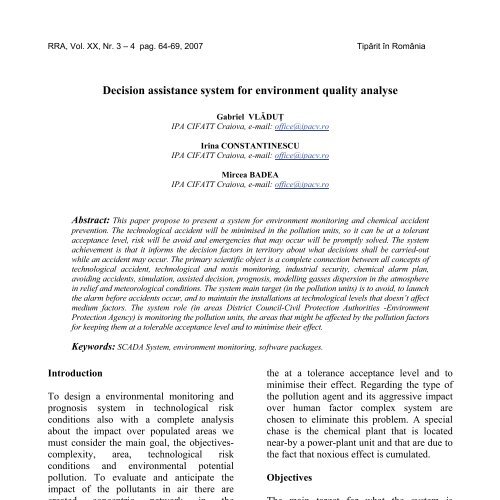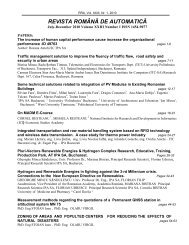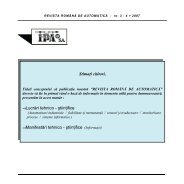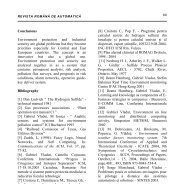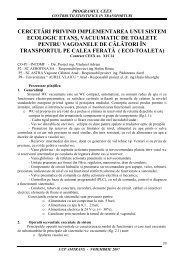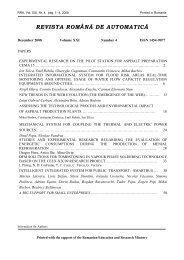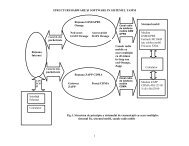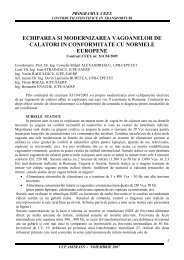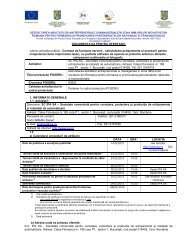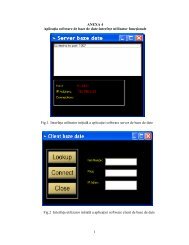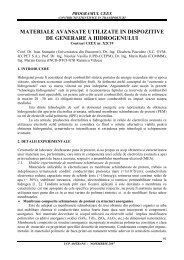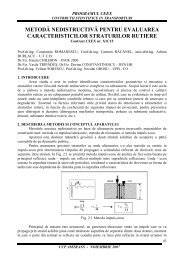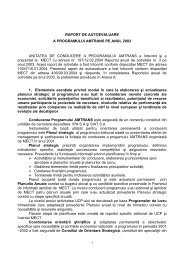Part II - IPA SA
Part II - IPA SA
Part II - IPA SA
Create successful ePaper yourself
Turn your PDF publications into a flip-book with our unique Google optimized e-Paper software.
RRA, Vol. XX, Nr. 3 – 4 pag. 64-69, 2007 Tiprit în România<br />
Decision assistance system for environment quality analyse<br />
Gabriel VLDU<br />
<strong>IPA</strong> CIFATT Craiova, e-mail: office@ipacv.ro<br />
Irina CONSTANTINESCU<br />
<strong>IPA</strong> CIFATT Craiova, e-mail: office@ipacv.ro<br />
Mircea BADEA<br />
<strong>IPA</strong> CIFATT Craiova, e-mail: office@ipacv.ro<br />
Abstract: This paper propose to present a system for environment monitoring and chemical accident<br />
prevention. The technological accident will be minimised in the pollution units, so it can be at a tolerant<br />
acceptance level, risk will be avoid and emergencies that may occur will be promptly solved. The system<br />
achievement is that it informs the decision factors in territory about what decisions shall be carried-out<br />
while an accident may occur. The primary scientific object is a complete connection between all concepts of<br />
technological accident, technological and noxis monitoring, industrial security, chemical alarm plan,<br />
avoiding accidents, simulation, assisted decision, prognosis, modelling gasses dispersion in the atmosphere<br />
in relief and meteorological conditions. The system main target (in the pollution units) is to avoid, to launch<br />
the alarm before accidents occur, and to maintain the installations at technological levels that doesn’t affect<br />
medium factors. The system role (in areas District Council-Civil Protection Authorities -Environment<br />
Protection Agency) is monitoring the pollution units, the areas that might be affected by the pollution factors<br />
for keeping them at a tolerable acceptance level and to minimise their effect.<br />
Keywords: SCADA System, environment monitoring, software packages.<br />
Introduction<br />
To design a environmental monitoring and<br />
prognosis system in technological risk<br />
conditions also with a complete analysis<br />
about the impact over populated areas we<br />
must consider the main goal, the objectivescomplexity,<br />
area, technological risk<br />
conditions and environmental potential<br />
pollution. To evaluate and anticipate the<br />
impact of the pollutants in air there are<br />
created concentric network in the<br />
technological installation, round about the<br />
pollution units and close by the impact areas.<br />
The technological risk will be minimised in<br />
the pollution units, so it can be at a tolerant<br />
acceptance level, risk will be avoid and<br />
emergencies that may occur will be promptly<br />
solved. The system main target is to avoid, to<br />
launch the alarm before accidents occur, and<br />
to maintain the installations at technological<br />
levels that doesn’t affect medium factors. The<br />
system role, in areas is monitoring the<br />
pollution units, the areas that might be<br />
affected by the pollution factors for keeping<br />
the at a tolerance acceptance level and to<br />
minimise their effect. Regarding the type of<br />
the pollution agent and its aggressive impact<br />
over human factor complex system are<br />
chosen to eliminate this problem. A special<br />
chase is the chemical plant that is located<br />
near-by a power-plant unit and that are due to<br />
the fact that noxious effect is cumulated.<br />
Objectives<br />
The main target for what the system is<br />
created, is sustaining the human effort<br />
(correlated in the monitoring units, in<br />
intervention and supervision organisms), in<br />
taking the optimum solutions while the<br />
chemical alarm may occur, and that can be<br />
realise by informing the personnel about the<br />
specific measures he must take at his work<br />
place. The system finality will consist in a<br />
united and operative database that will be<br />
able to present solutions for avoiding or/and<br />
minimising risks for the units and near-by<br />
areas and regions. The system has four 4<br />
components:


